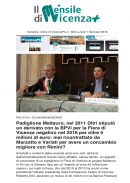Rating S&P della Banca Popolare di Vicenza crolla a BB+ da BBB-. Ma tutto tace
Sabato 4 Agosto 2012 alle 23:53 | 0 commenti

Come riferito prima dalle agenzie e dai media web e poi oggi anche dai quotidiani italiani, Standard & Poor's, l'agenzia di rating a cui la Banca Popolare di Vicenza ha affidato la valutazione del suo rating, ieri ha diffuso i suoi dati impietosi per 32 banche italiane tra cui 15 primari istituti bancari e, in particolare, quello presieduto da Gianni Zonin (nella foto col Dg Samuele Sorato). La BpVI, infatti, si è visto pericolosamente abbassare nuovamente e dopo pochi mesi il rating a lungo termine dal precedente, già preoccupante, BBB- a BB+. Anche l'indice a breve è sceso passando da A-3 a B. Il tutto con outlook (previsioni sul futuro) negativo.
Sono oltre due mesi che alla banca di Via Btg. Framarin i nostri media hanno chiesto, ripubblicandole anche su ogni numero del quindicinale, spiegazioni per i lettori locali, che in gran misura è lecito pensare siano anche correntisti se non azionisti della Banca. Tutto questo invano, mentre nell'assemblea plenaria dell'Istituto sono stati ufficializzati addirittura dei valori maggiori delle proprie azioni, che, ricordiamo, non sono quotate in borsa e, quindi, non sono sottoposte alle valutazioni del mercato ma valorizzate solo in base a quotazioni tecniche commissionate dalla banca stessa a "expertise".
Lasciando la porta aperta a responsabili contatti che la BpVI volesse avere, per nostro tramite, con chi è interessato alle sue sorti e alle questioni che le abbiamo tecnicamente sottoposto, non possiamo non rendere pubbliche e rinnovare le preoccupazioni che la stampa leader locale non attenua, di fatto, occupandosi anche oggi della crisi bancaria di ... Unicredit ma nascondendo da tempo i vari downgrading della banca leader locale, tra l'altro decretati da un'agenzia di rating che dalla Banca Popolare di Vicenza stessa è pagata per fare le suddette valutazioni.
Che queste risentano del sistema Italia è indubbio, ma non capiamo i motivi dei silenzi interni ed esterni all'istituto, uno dei primi dieci in Italia, recitano le sue referenze interne, per cui, in attesa di stilare eventuali e meditate considerazioni col supporto di tecnici, ci limitiamo a pubblicare di seguito e integralmente il testo che la Standard & Poor's ha diffuso per informare sul downgrading e per supportare le sue valutazioni.
Perchè i lettori si informino e valutino.
Tutto e tutti.
Research Update: Italian Banca Popolare di Vicenza Downgraded To 'BB+/B' On Increased Credit Risk For Italian Banks; Outlook Negative
Â
Publication date: 03-Aug-2012
With Italy facing a potentially deeper and more prolonged recession than we had originally anticipated, we are of the view that the vulnerability of Italian banks to the impact of rising loan losses has increased due to the combined effect of mounting problem assets and reduced coverage of loan loss reserves.
•In our view, Banca Popolare di Vicenza ScpA (BPVi) is vulnerable to the effects of increases in its already high stock of nonperforming assets (NPAs), given that its coverage of NPAs through provisioning is lower than the Italian banking system average.
•Therefore, we are lowering our long- and short-term ratings on BPVi to 'BB+/B' from 'BBB-/A-3'.
•The negative outlook reflects the possibility of a downgrade if we were to lower our sovereign ratings on Italy and if we anticipate that a further deterioration in domestic economic and banking industry conditions could weaken BPVi's stand-alone credit profile.
Rating Action
On Aug. 3, 2012, Standard & Poor's Ratings Services lowered its long- and short-term counterparty credit ratings on Italy-based Banca Popolare di Vicenza ScpA (BPVi) to 'BB+/B' from 'BBB-/A-3'. We also lowered our rating on
BPVi's nondeferrable subordinated debt to 'BB-' from 'BB+'. The outlook is negative.
Rationale
The downgrade reflects our opinion that BPVi's financial profile, and in particular its risk position, is negatively affected by what we see as increased risk in the economy (see "BICRA On Italy Maintained At Group '4', Economic Risk Score Revised To '5' On Increased Credit Risk For Italian Banks,"Â published Aug. 3, 2012, on RatingsDirect on the Global Credit Portal).
With Italy facing a potentially deeper and more prolonged recession than we had originally anticipated, we are of the view that Italian banks' vulnerability to credit risk in the economy is rising. In this context, we believe that the combined effect of mounting problem assets and reduced coverage of loan loss reserves make banks mores vulnerable to the impact of higher credit losses, particularly in the event of deterioration in the collateral values of assets.
Because of the increased economic risk we see in Italy and the negative impact we see for BPVi's risk position, we have revised down our assessment of BPVi's stand-alone credit profile (SACP) to 'bb+' from 'bbb-', which in turn has resulted in the lowering of our ratings on BPVi to 'BB+/B' from 'BBB-/A-3'.
According to our methodology, we rate nondeferrable subordinated debt issued by banks in Italy a minimum of two notches below the SACP when the SACP is 'bb+' or lower. As such, we are lowering our rating on BPVi's subordinated debt to 'BB-' from 'BB+'.
Our opinion of the increased credit risk in the Italian economy negatively affects our calculation of BPVi's future risk-adjusted capital (RAC) ratio, although not sufficiently for us to modify our assessment of its capital and earnings as "moderate," as our criteria defines the term. We now forecast that BPVi's RAC ratio will range between 5.2% and 5.5% in the next 24 months, compared with our previous expectations of 6.0%-6.5% and our revised 2011 RAC
ratio of 5.2% pro forma for the increased economic risk in Italy. We anticipate that BPVi's earnings capacity will remain modest in 2012 and 2013, as a result of weak credit growth, a still-high cost base, and high loan loss provisions. Our current projections don't factor in any capital injection from shareholders, although we note BPVI's strong record of shareholder support in recent years.
We believe that our RAC estimates do not fully capture BPVi's vulnerability to the now more negative economic environment in Italy and we have therefore revised our assessment of the bank's risk position to "moderate" from "adequate." In our opinion, a more severe recession will likely push to high levels BPVi's stock of problem assets--which we define as the sum of bad loans ("sofferenze") and watchlist loans ("incagli")--in 2012 and 2013. At the same time, BVPi's coverage of problem assets through provisioning, which was already low by international standards because of the bank's extensive use of tangible collateral in its assessment of provisioning needs, has decreased further over the past few years. Coverage of problem assets declined to 31% in March 2012 from 39% at year-end 2008. Problem assets not covered by provisions now represent 80% of the bank's Tier 1 capital compared with a domestic average of 54.3%. As a result, BPVi's stock of net nonperforming assets (NPAs; these also include restructuring loans and loans past due) reached a high 7.6% of gross loans at year-end 2011 compared with 3.2% in 2008.
Our SACP and ratings on BPVi continue to reflect the "anchor" of 'bbb' we assign to commercial banks operating in Italy (the anchor is our starting point for assigning a bank a long-term rating), as well as our view of BPVi's "adequate" business position, "average" funding, and "adequate" liquidity, as our criteria define these terms.
We consider BPVi to have moderate systemic importance and the Italian government to be supportive of its banking sector. We continue to evaluate the likelihood of government support for BPVi as "moderate" but we do not incorporate any uplift into the long-term rating from the SACP, given the 'BBB+' long-term rating on Italy.
Outlook
The negative outlook on the long-term rating on BPVi reflects the possibility of a downgrade if we were to lower our ratings on the Republic of Italy (unsolicited, BBB+/Negative/A-2) and we anticipated that deteriorating economic and banking industry conditions in Italy could affect BPVi's asset quality, capital, and earnings more than we currently factor into the ratings.
A deterioration of the SACP on BPVi while the sovereign long-term rating on Italy remained at 'BBB+' would not necessarily trigger a downgrade because we might factor in one notch of uplift above the SACP for government support.
Under our baseline expectations, we still expect the RAC ratio for BPVi to remain above 5% over the next two years, although BPVi's potential to cushion a further increase in domestic economic risk has decreased. The bank's NPAs are likely to accumulate at rates above those of 2011, both in 2012 and 2013, but still below the peak in 2009. We forecast that BPVi's net inflows of NPAs in 2012 will remain close to our expected banking system average of 2.6% of customer loans. We expect the bank's credit losses to remain close to our forecast Italian domestic average, at 95-100 basis points (bps) in 2012 and 2013. In addition, our rating factors in our view that BPVi will maintain an average funding position and adequate liquidity. We think that the bank will benefit from its deep retail customer base and continue to further reduce its 129% loan-to-retail funding ratio over the next two years, as in 2011 and the first few months of 2012.
We could lower the ratings if we anticipate that BPVi's RAC ratio will not remain sustainably above 5% over the next 24 months and if we anticipate that its net inflows of NPAs and credit losses will exceed our current expectations.
We could revise the outlook to stable if we anticipate an improvement in economic and operating conditions for the Italian banking system and a strengthening of BPVi's capital and earnings position, as well as a pronounced easing of asset quality deterioration.
Ratings Score Snapshot
Issuer Credit Rating BB+/Negative/B
SACP bb+
Anchor bbb
Business Position Adequate (0)
Capital and Earnings Moderate (-1)
Risk Position Moderate (-1)
Funding and Liquidity Adequate (0)
Support 0
GRE Support 0
Group Support 0
Sovereign Support 0
Additional Factors 0
Related Criteria And Research
•Rating Actions Taken On 32 Italian Financial Institutions On Increased Credit Risk In Italy's Economy, Aug. 3, 2012
•Banks: Rating Methodology And Assumptions, Nov. 9, 2011
•Banking Industry Country Risk Assessment Methodology And Assumptions,
Nov. 9, 2011
•Group Rating Methodology And Assumptions, Nov. 9, 2011
•Bank Hybrid Capital Methodology And Assumptions, Nov. 1, 2011
•BICRA On Italy Maintained At Group '4', Economic Risk Score Revised To '5' On Increased Credit Risk For Italian Banks, Aug. 3, 2012
Ratings List
Downgraded
To From
Banca Popolare di Vicenza ScpA
Counterparty Credit Rating BB+/Negative/B BBB-/Negative/A-3
Certificate Of Deposit BB+/B BBB-/A-3
Senior Unsecured BB+ BBB-
Subordinated BB- BB+
Complete ratings information is available to subscribers of RatingsDirect on the Global Credit Portal at www.globalcreditportal.com . All ratings affected by this rating action can be found on Standard & Poor's public Web site at www.standardandpoors.com. Use the Ratings search box located in the left column.Â
Accedi per inserire un commento
Se sei registrato effettua l'accesso prima di scrivere il tuo commento. Se non sei ancora registrato puoi farlo subito qui, è gratis.





